Recipes | Chefs off the Clock
Recipes
-
Lacquered Aged Moulard Duck Breast with Flavors of the Forest
Recipe by Carrie Nahabedian (Naha, Brindille)
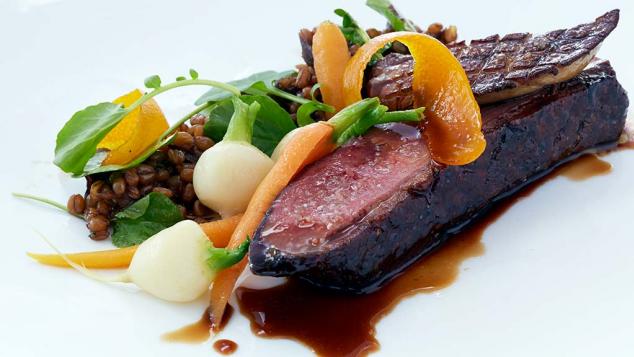
Serves 2
- 1 Moulard duck breast
- 4 French breakfast radishes, depending on size
- 10 crosnes
- 8 Thumbelina carrots
- Pinch of fennel seeds
- Olive oil
- Salt
- Cracked black pepper
- Soft butter
- Port to deglaze
Molasses mixture
- 2 oz. molasses
- Pink peppercorns
- 1 oz. white truffle honey
- 2 oz. blossom honey
- 2 oz. Burton’s maple syrup
Candied Orange
- 1 orange
- 1 cup sugar
- 1 cup water
Poached cranberries
- ½ lb. fresh cranberries
- 8 oz. duck or veal stock
- 2 oz. Minus 8 ice vinegar
- 6 oz. freshly juiced orange juice
- 1 split vanilla bean
- 1/4 cup sugar
- 1 star anise
Method
- Combine the molasses, honey, and maple syrup together and heat up in a saucepot. Add a few pink peppercorns for flavor. Keep warm. This mixture can be kept refrigerated for a week.
- Peel the radishes. I personally don’t like to, but some people like the peel off. If they have a nice top of leaves, keep the leaves on. If they are large, you will need less for garnish. In a sauté pan, slowly sweat the radishes in soft butter, season, and cook until tender. If they are petite, use them whole; if not, split them in half lengthwise.
- Prepare the crosnes – if necessary! They are “self-contained,” so they don’t need any attention; just LOVE and respect! Prepare just like the radishes.
- To make candied orange, make light syrup: bring 1 cup of sugar to a boil with 1 cup of water. Remove from the heat. With a peeler, taking care not to peel the white pith of the orange, peel the rind. Julienne the rind into fine strips. Blanch quickly in hot water to remove oils, then refresh under cold water. Add to the syrup and cook for 10 minutes over low heat. Reserve. It can be refrigerated for future use.
- Prepare a light syrup gastrique: in a heavy saucepot, place the sugar in the pan over medium high heat, stirring with a wooden spoon as the sugar caramelizes. Remove from the heat and add the Minus 8 vinegar. Return to the heat, add the orange juice, and bring to a boil. Add the fresh cranberries, star anise, and the split vanilla bean. Bring back to a quick simmer and just as the cranberries begin to “pop,” remove from the heat.
- Peel the Thumbelina carrots and place in cold water to remove any dirt around the stem. Blanch quickly to refresh. Sauté in whole butter with a touch of toasted fennel seeds; caramelize the carrots. Set aside.
- Trim the excess fat from the duck breast and score the fat on the breast for even cooking. Season generously on both sides with kosher salt and cracked black pepper. Sear the breast in a heavy sauté pan over medium to high heat on the fat side. Lower the heat once it browns and baste the bird breast without turning it over. Once the fat has rendered on the bird, flip the breast onto the skin side for just a moment. Then flip it back and generously “lacquer” the bird with the molasses mixture.
- Keep basting it until the breast is medium rare. Remove breast from the pan, pour off excess lacquer, and let rest on a rack. Deglaze the pan with a nice splash of port, the pink peppercorns, and a little water to loosen all the lacquer. Add 8 oz. duck jus, bring to a boil, reduce by a third, and add in a knob of soft butter, a splash of port, 2 oz. of the candied orange, and poached cranberries. Keep warm.
- Slice the duck into medium-thick slices, cross-grain lengthwise. Garnish with the radishes and crosnes and spoon the sauce over the duck.
-
Giardiniera
Recipe by Mychael Bonner (Petterino’s, Saranello’s, Di Pescara, Ivy Room)
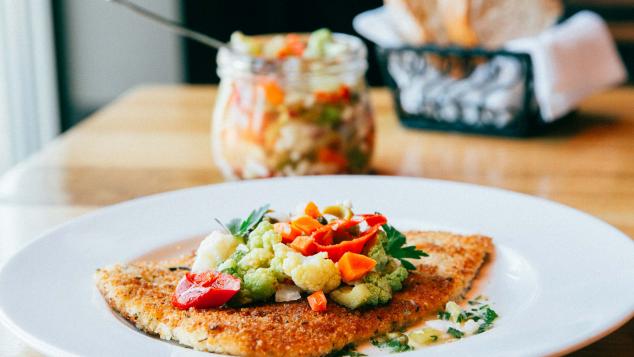
Giardiniera literally translates to "from the garden," and this is the way Saranello's Chef Partner Mychael Bonner approaches his version of this traditional condiment. Rather than just using hot peppers, Chef starts with roughly chopped vegetables that are in season; including sweet peppers, onions, cauliflower, carrots, celery and Fresno peppers. These are combined and brined with Chef's special mix of vinegar, olive oil and herbs. It becomes a crunchy, pickled salad that can even be eaten as an antipasti. The best ingredients are made from peak season vegetables, including those grown down the road at Wheeling’s own Horcher Farms.
Makes approximately 1 gallon of giardiniera that lasts up to six months.
Ingredients
- 2 1/2 cups carrot (1/2” diced)
- 2 1/2 cups celery (1/2” diced)
- 2 1/2 cups cauliflower florets (1/2” diced)
- 2 1/2 cups red pepper (1/2” diced)
- 2 1/2 cups green pepper (1/2” diced)
- 2 1/2 cups red onion (1/2” diced)
- 1 cup capers, rinsed and drained
- 1 cup Fresno peppers (1/2” diced)
- 2 1/2 tbsp Pimento‐stuffed green olives (1/2” diced)
- 4 cups light olive oil
- 2 1/2 tbsp dried oregano
- 1 quart water
- 1 quart white distilled vinegar
- 2 1/2 tbsp kosher salt
Method
- Bring the water, vinegar, and salt to a boil. Add all diced fresh vegetables and return to a boil. Turn the heat off and allow to sit for 1 hour.
- Drain the vegetables, reserving 4 cups of the pickling liquid.
- Combine the vegetables with the olive oil, capers, pickling liquid, and oregano. Divide into hot sterilized mason jars, and cover with lids.
- Place jars in a hot water bath, and bring to a boil for 15 additional minutes.
- Remove jars; allow to cool.
- Repeat final 2 steps for any jars that don’t seal.
-
Ravioli di “Piccolo Sogno”
Recipe by Tony Priolo (Piccolo Sogno, Nonnina and Maillard Tavern)
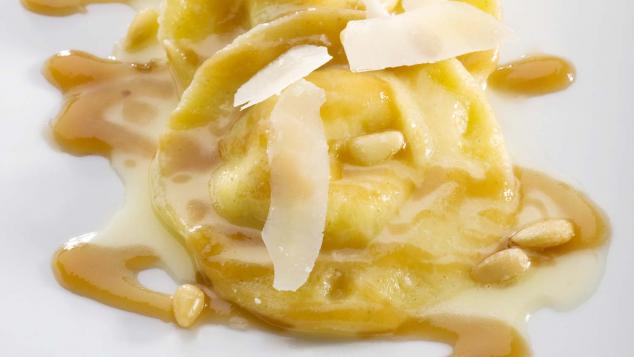
Filling
- 1 cup fresh ricotta cheese
- 1/8 cup freshly grated Parmigiano Reggiano
- 1/8 cup goat cheese
- 1/8 cup chopped gorgonzola dolcelatte cheese
- 1 teaspoon chopped Italian parsley
- Sicilian sea salt to taste
- Fresh ground black pepper to taste
- Mix all ingredients together in a bowl and adjust the seasoning.
Pasta Dough
- 4 whole eggs
- 4 egg yolks
- 1 tbsp olive oil
- 1 tsp Sicilian sea salt
- 2 3/4 cups semolina flour
- 1 1/4 cup all-purpose flour
- 2 tbsp water
Method
- (Method 1) In a food processor, add all ingredients. Pulse until a ball forms; or, (Method 2) In a large bowl add all dry ingredients into center of the bowl. Make a small well in the center of the dry ingredients and add the remaining ingredients. With a fork, beat the liquid until smooth, slowly touching the sides and incorporating the dry ingredients. Keep mixing until a ball is formed.
- Take the ball out and knead by hand until the dough is slightly firm. (The texture should be slightly firmer than your ear lobe.) You may need to adjust the water amount due to the humidity in the air.
- After the dough has rested, roll it out progressively with a pasta machine until the dough is thin enough that you can see your hand through it.
- Brush the dough with egg yolk and add a quarter-sized dollop of filling on half of the dough with a spoon.
- Place the other half of the dough over the side with the filling so that you can form ravioli. With a small shot glass, form the center of the ravioli and press all the air out.
- Cut with a circle cutter so that there is a small edge around the center.
- Press the sides, gently pushing the air out, and set aside.
- Cook in boiling salted water for about 2 minutes, then toss into the sauce.
For the Sauce
- 1/2 cup fresh chicken broth
- 2 tbsp unsalted butter
- 1 tbsp toasted pine nuts
- Sicilian sea salt to taste
- Black pepper to taste
*Marsala glaze: 1 cup marsala wine cooked down by three-quarters until it is thick. You can use a cornstarch slurry to thicken.
*Shavings of Parmigiano-Reggiano: Using a potato peeler, lightly shave off curls of cheese from a solid piece for the garnish.
- In a sauce pan, reduce the chicken broth down by half. Add the butter and bring to a boil, then take the sauce off the heat. Stir quickly so the sauce does not break.
- Add the cooked ravioli and toasted pine nuts. Adjust the seasoning.
- Drizzle about six ravioli on a plate with sauce and marsala glaze, sprinkle with pine nuts, and top with shavings of parmesan cheese. Serve immediately.
-
Mejillones
Recipe by Carlos Gaytan (Mexique)
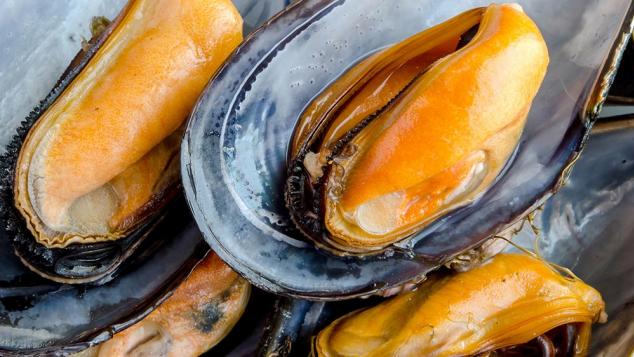
Ingredients
- Diced shallots
- White wine
- Saffron
- Heavy Cream
- Butter
- Dry Chorizo
- Salt
- Pepper
- Lemon juice
- Jalapenos
- Fennel
- Olive oil
- Mussels
Method
- In a saucepan, add diced shallots, white wine, and saffron. Reduce for 15 minutes over low heat, then add heavy cream and reduce for another 10 minutes or until you see sauce come together with the heavy cream.
- Add butter in medium-sized squares. Blend. Add salt, pepper, and lemon juice to taste
- In a separate large pan, heat olive oil. Add dry chorizo, fennel, jalapenos, and mussels. Saute for 5 minutes, then add white wine and let simmer for 2 minutes.
- Add prepared cream sauce and serve immediately with crostinis.
-
Won Kim’s Vegan Kimchi Sludge
Recipe by Won Kim (Kimski)
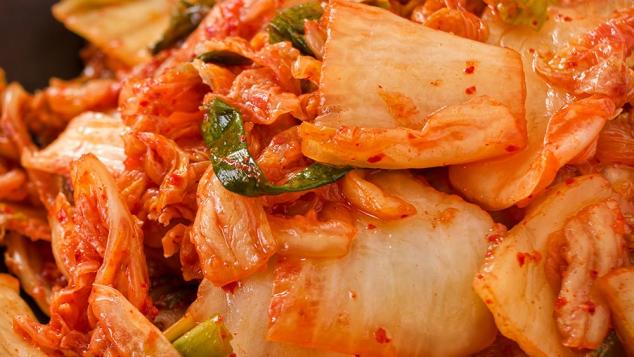
This is a simple recipe for your basic kimchi-ing needs. It is basically the fermenting mixture used to make traditional Napa cabbage kimchi or to make any root vegetable or leafy green into a tasty spicy kimchi side!
Makes 1 quart of sludge
Ingredients
- 8 cloves of garlic
- 1 large knob of ginger, roughly sliced
- 1 bunch of scallion, chopped
- 2 carrots, shredded or julienned
- 2 daikon radishes, shredded or julienned
- 1 tbsp of sugar
- 6 tbsp of sea salt
- 2 cups of gochugaru
Optional (to taste):
- Rice vinegar
- Tamari or soy sauce
- Grated Asian pear
Method
- Add garlic and sliced ginger to a blender with 2 cups of hot water and blend.
- Combine all ingredients into a large mixing bowl and mix and combine with chopped salted Napa cabbage, root vegetables, or any leafy green, and leave out overnight until slightly wilted.
- Refrigerate. It should be ready within a day or two. Stays good up to a month!
-
Sticky Beef Ribs with Guava BBQ Sauce
Recipe by Rick Gresh (AceBounce, Flight Club)
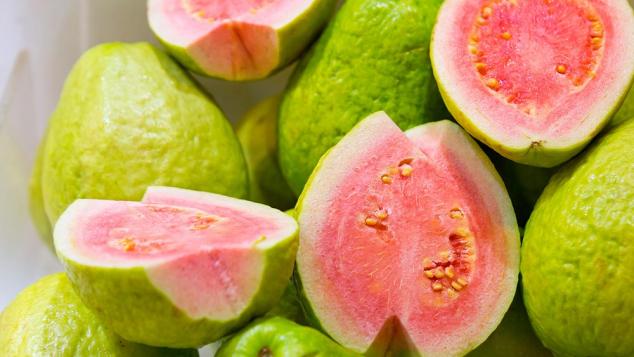
Ingredients
- 2 racks beef back ribs
- 1 cup apple juice
Dry rub
- 10 oz sugar
- 5 oz salt
- 5 oz dry mustard powder
- 3 tbsp and 2 tsp chinese five-spice powder
- 1 tbsp and 2 tsp black pepper, ground
- 1 tbsp and 2 tsp cinnamon, ground
- 2 1/2 tsp clove, ground
- Dry sherry wine in a squirt bottle, as needed
Method
- Combine all of the ingredients in the dry rub and sprinkle over the meat.
- Place ribs in the grill/smoker over indirect heat at 250 degrees F. Smoke for 45 minutes. Begin to spray with sherry after 45 minutes, spraying every 15 minutes. Smoke for an additional 2 1/2 hours.
- Place ribs in a foil pan, add apple juice, and cover with foil. Place back in the smoker and cook for 2 more hours.
- Remove foil and glaze ribs with guava BBQ sauce, then cook for 30 more minutes uncovered.
Guava BBQ sauce
- 40 oz guava paste, large diced
- 1 2/3 cup cider vinegar
- 1 1/4 cup dark rum
- 7 1/2 oz tomato paste
- 7 1/2 oz lime juice
- 2 1/2 oz soy sauce
- 2 1/2 oz worcestershire sauce
- 3 1/2 oz ginger, finely minced
- 5 green onions, white part only
- 5 garlic cloves, finely minced
- 1 1/4 cup water
Method
- In a sauce pan, combine all ingredients and bring to a boil. Simmer over low heat until reduced.
- Adjust to taste with salt and pepper.
-
Chicken Nuggets
Recipe by Zoë Schor (Split-Rail)
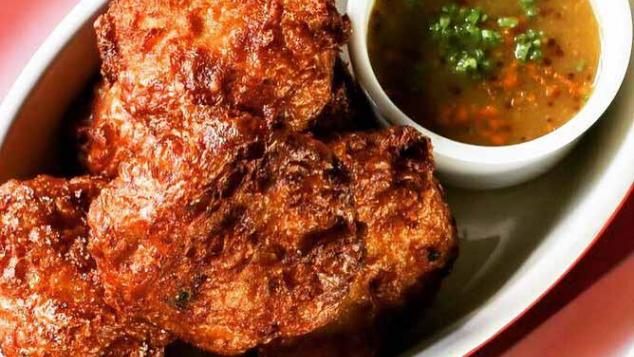
Serves 8
For the nuggets
- 2 3/4 lbs. boneless, skinless chicken thighs, cleaned and diced
- 20 g kosher salt
- 16 g rye whiskey
- 80 g egg whites
- 60 g minced jalapeno (with seeds removed)
- 75 g minced shallot
- 25 g minced garlic
For the breading and frying
- 6 cups all-purpose flour
- 1 tbsp ground black pepper
- 2 tbsp kosher salt
- 6 cups buttermilk
- 1/2 tsp baking soda
- 1/2 tsp baking powder
- Splash of rye whiskey
- Water
- Neutral oil for deep frying
To Make the Nuggets
- In a food processor, combine the chicken, salt, and rye whiskey. Process until a smooth paste forms, then slowly drizzle in the egg whites while the motor is running. If your food processor cannot run with the lid open, add the egg whites a little bit at a time, processing in between.
- Remove to a bowl and use a rubber spatula to fold in chiles, garlic, and shallots.
- Form the nuggets: you can use a scoop to portion, or just use your hands. We use a scoop to form a 1 oz. ball, then form that into a nugget shape.
- Freeze until hard – this step is important because the nuggets will be very difficult to bread if not frozen.
To bread and fry
- In a large, heavy-bottomed pot, heat your cooking oil to 325 degrees (you can use a candy thermometer to test the temperature). Make sure you have enough oil to deep fry all of your nuggets, but also that there’s plenty of space between the top of the oil and the top of the pot.
- Combine 4 cups of all-purpose flour with the salt and pepper and put in a large dish or baking pan. Put 2 cups of buttermilk in another large dish (you may wind up having to top this off before you’re through).
- In batches, dredge the nuggets in the seasoned flour, then the buttermilk, then back to the flour. This is a delicate process, as you don’t want to incorporate excess buttermilk into your flour. Try to work quickly and cleanly so your nuggets come out nice. Do not discard the seasoned flour when finished!
- When all your nuggets are breaded, carefully deep‐fry them; we recommend using a wire skimmer to place them into and take them out of the oil. They should fry for about 3–4 minutes, until a light golden brown color.
- Remove all the nuggets to a paper towel‐lined tray and allow to cool thoroughly. Do not discard the oil!
- Bring the cooking oil back up to 350 degrees.
- Sift the seasoned flour to remove any particulate or buttermilk. You will have lost some of the original volume, which is okay; you need a pint, total. If you have less than this, use some of the excess flour to reach a pint.
- Combine the pint of flour with a quart of buttermilk and beat with a whisk until smooth; add the baking soda and baking powder, and the rye whiskey.
- In batches, dredge the cooled nuggets in this batter and, lightly scraping off any excess batter, carefully place in the hot oil. Fry for another 3‐4 minutes, until golden brown.
- When removing from oil, season immediately with fine salt and lay on a paper towel-lined tray. Repeat until all nuggets are finished.
-
Strawberry Rhubarb Pie
Recipe by Molly Svec (Spilt Milk)
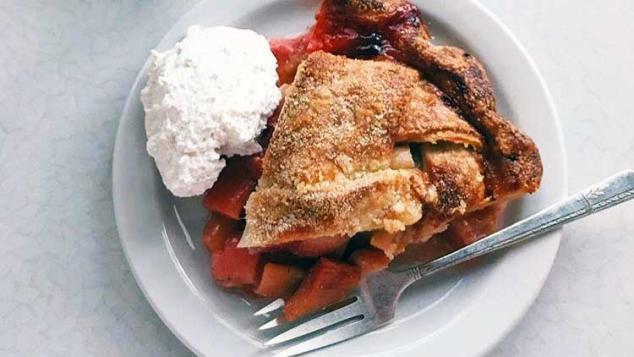
Pie dough
- 2 1/2 cup all-purpose flour
- 1 tbsp kosher salt
- 1 tbsp sugar
- 8 oz. cold butter
Dough water
you will not use this entire amount
- 1 cup cold water
- 2 Tablespoons apple cider vinegar
Cut butter into dry ingredients; we find that a food processor works best. Pulse until mixture is somewhat uniform looking, without big chunks of butter.
- Start to add dough water, about 3 tbsp to start. Using a wooden spoon, stir the mixture until it starts to come together. Be sure to scrape off the spoon as you go to get the wet bits off of the side and into the mixture. If it still seems quite dry, add the water tsp by tsp until the dough comes together into a shaggy mass.
- Turn the dough out onto the table and work it a bit to get it to come together into 2 flat discs. Cover with plastic and refrigerate at least 2 hours.
- Now you’re ready to make a pie! Remove the dough from the refrigerator and roll each ball out to fit a 9-inch pie tin, rolling it to about a 12-inch round. Fit one of the rounds into your buttered and floured pie tin. Refrigerate these while you get everything else set.
Filling
- 3 tbsp tapioca starch
- 3 tbsp arrowroot powder
- 1 1/4 cup sugar
- Pinch of salt
- Pinch of black pepper
- 4 cups rhubarb, peeled and chopped into 2-inch pieces
- 2 cups strawberries, hulled and cut into medium pieces
- 1 tbsp fresh lemon juice
- Start with the tapioca starch, arrowroot poweder, sugar, salt, and pepper in the bowl. Mix them to make sure there are no lumps. Add the fruit and lemon juice. Mix until combined. There will be a bit of dry mix in the bottom of the bowl. Don’t worry! It’ll all go into the pie and be just fine.
- Grab your dough out of the fridge. Sprinkle a tbsp each of sugar and flour on the bottom of the pie crust in the tin, then mix it around with your fingers. This will help to thicken the fruit juices that go to the bottom of the pie and keep the crust from getting soggy.
- Now, add your fruit mixture – be sure to scrape all of the dry mix from the bowl and your spatula – you don’t want to miss any of that!
- Top the pie with the other round of dough. Press the two pieces of dough together along the rim of the pie tin to seal the outer edge. You’ll want to trim the excess dough along the edge; there should be about an inch of dough hanging over. Crimp around the edge.
- Put your pie in the freezer for about 1 hour.
- Preheat the oven to 375 degrees.
- Brush your pie with a 50\50 mixture of cream and milk, but be careful that it doesn’t pool too much around the crust. Generously sprinkle with granulated sugar, and cut decorative vents in the top. Place in your preheated oven on a sheet pan. Bake for 20 minutes at 375. Reduce heat to 350 and continue baking your pie for about another hour. Check the internal temperature of the pie with an instant-read thermometer stuck into the pie one inch from the outer crust. It is done baking when it reaches 212 degrees. The goo leaking from the pie should be quite thick and sticky looking. If the crust is browning too quickly, use foil to cover the parts that are getting dark.
- Once the pie is done baking, let it cool entirely! Do not slice it while it’s warm or the juices will run and you’ll end up with a watery pie.
-
Summer Farfalle
Recipe by Carolina Diaz (Terzo Piano at the Art Institute of Chicago)
Serves 6
For the Basil-Ricotta Cream
- 1 cup fresh basil
- 1/2 cup parsley
- 1 cup fresh ricotta
- 2 cups heavy cream
- 1 tbsp salt
- 1 tbsp white vinegar
Combine all ingredients in a blender until smooth and set aside.
For the Pasta
- 1 lb of cooked farfalle pasta (reserve some pasta water)
- 1 cup extra virgin olive oil
- 1 cup onion, chopped
- 1 tbsp garlic, minced
- 1 cup cherry tomatoes, cut in half
- 1/2 cup baby zucchini, cut into small coins
- 1/2 cup radishes, sliced
- 1/2 cup sugar snap peas
- 2 tbsp parsley, chopped
- 2 tbsp mint, chopped
- 1 tbsp salt
- Parmigiano Reggiano for serving
Method
- In a large saute pan over medium heat, saute onion and garlic with olive oil until translucent.
- Add the rest of the ingredients and saute for 3 minutes.
- Add the cooked pasta and a bit of the pasta water to the saute pan and turn the heat off.
- Toss the pasta with the basil-ricotta cream until evenly coated.
- Garnish with freshly grated Parmigiano Reggiano cheese.





